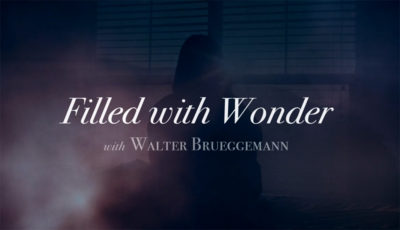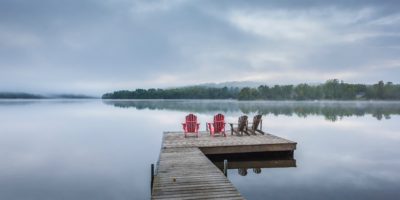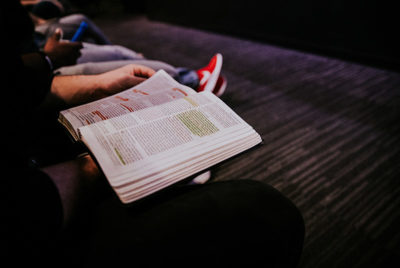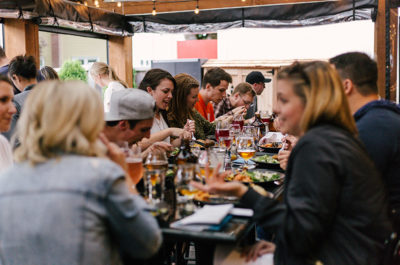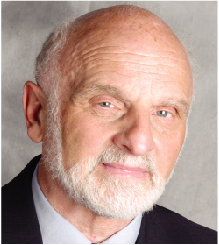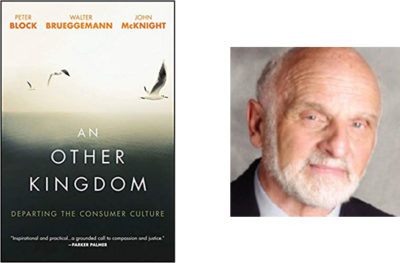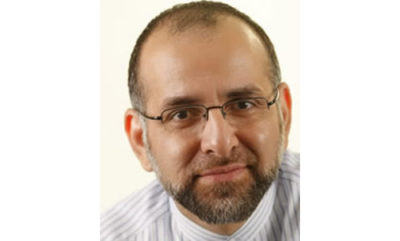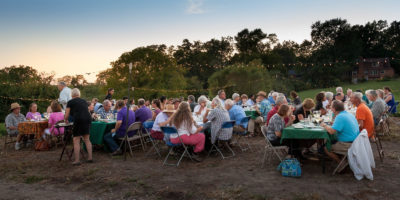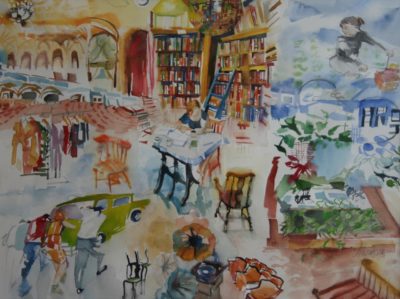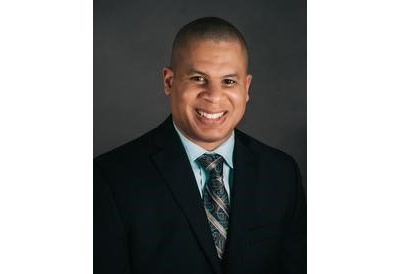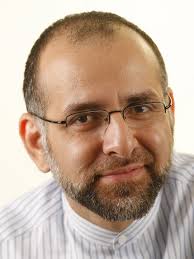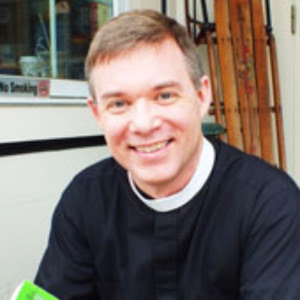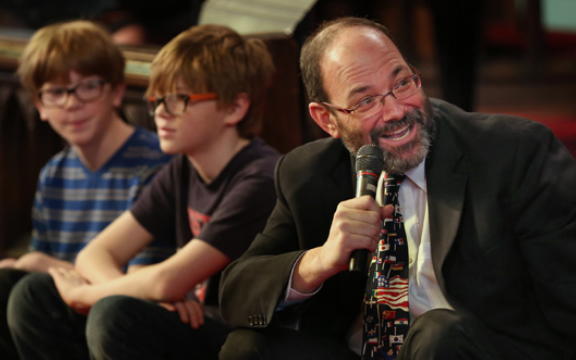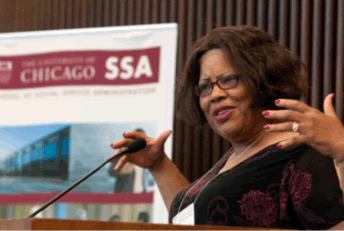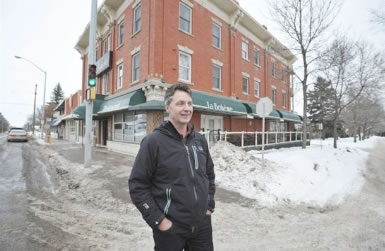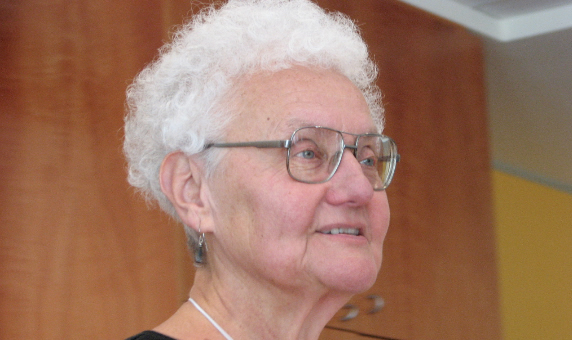Tag Archives: Faith
Walter Brueggemann: Lament and Narratives
Filled with Wonder
Meditating on a Neighborly Economy
Consumerism and Jubilee
Bringing Forth Jubilee in 2019
Faith and Church with No Bricks and Mortar: Conversation with Father Joseph Kovitch
Since their book The Abundant Community came out, John McKnight and Peter Block have sought out those social innovators who are bringing alive the ideas about how neighbors and local institutions can come together to create care, kindness, and welcome. One of those innovators is Father Joseph Kovitch. Peter and John talked with him in June of 2018. They are still in touch with him and what he describes here is still vibrant today.
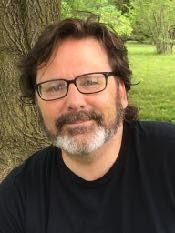
Father Joe was a priest of Saint Matthew’s Episcopal Community in Westerville, Ohio, who worshiped in an Irish pub and is currently on a university campus; they are also serving out of a community house nearby. He has been ordained for 30 years and has served in many ministries and missional environments, some of which include serving as leader of a large traditional congregation, leading a redevelopment merger of three congregations into a new mission, and, at this moment, serving as Diocesan Missioner for New Episcopal Communities in the Episcopal Diocese of Southern Ohio. Here is the conversation we had in 2018.
Listen to the Full Conversation:
The Parish in the Neighborhood
When we look at the Parish as a microcosm of all life’s dimensions, the conversation changes from traditional clergy talk of “butts, budgets and buildings,” to: What is God up to in our places, and how do we join in with that? Listen to Paul Sparks, Co-founding Director of the Parish Collective, discuss with Peter Block and John McKnight in this conversation:
Living Abundantly in an Age of Scarcity
From an Extractive to Neighborly Economy
Walter Brueggemann shares insight on today’s economy of extraction, a modern version of Pharaoh’s economy. The extractive economy is abnormal and the enemy of God’s intention for our neighborhood and our common humanness. Brueggemann describes to participants at the Conspire Gathering how when people left Pharaoh into the wilderness life supports were given. Listen:
Another Other Kingdom
Living into an Abundant Economy
Walter Brueggemann: Pharaoh’s Economy Today
On Finding Freedom
Debt and Usary in Islam
The Consumer Economy and its Crushing Assumptions
The Jubilee Campaign
Exploring transformational neighborhood change: Rich Jones
Visions of a Just Economy
Jubilee is an attempt to be a “ray of light that pierces through the darkness of fear,” says Adam Clark. In this audio recording, Adam, Associate Professor of Theology at Xavier University, talks with Peter Block about the modern vision of Jubilee – a biblical metaphor based on a period of economic re-distribution where slaves are set free, land is returned to its original owners and debts are forgiven.
Adam talks about the ideology of consumerism as a form of religion, the politics of disposability, distributing ownership and more in this radical conversation. Listen here:
Quotes:
“What’s so kind of remarkable about the consumer religion is that it’s not attached to any place. It’s all over. Any place is interchangeable . . . . The religion is something that thrives in homogenizing global culture.” – Adam Clark
“A beloved community is where everybody has some control over their economic lives and participates in the economy. That’s just never happened.” – Peter Block
Related Links:
View these videos of Adam Clark in conversation with Peter Block:
https://www.restorecommons.com/jubilee-professor-adam-clark/
https://www.restorecommons.com/professor-adam-clark/
Jubilee Forum 4 – Professor Waleed El-Ansary
Jubilee Forum 4, December 3, 2015
Professor Waleed El-Ansary, Islamic Scholar and Xavier Professor of Islamic Studies, speaking from the perspective of the Koran and Islamic culture on debt and economics. This includes how the land and earnings were committed to the common good. This means there was no such thing as consumer debt. He also explains the close connection between art, production and the presence of God. There was never a separation between science, work and spiritual meaning.
Jubilee Forum 3 – Reverend Rob Rhodes
Jubilee Forum 3, October 29, 2015
Reverend Rob Rhodes, host of Jubilee Forum 3 at Christ Church Cathedral, speaks in a very personal way about how financial institutions can draw us into debt almost without notice. The ease and subsequently high cost of debt pairs with the seduction of a certain life style to put us into very difficult conditions. He also notes that debt has become a substitute for increased wages. In the end Jubilee is not just about forgiveness, it also about liberation.
From Charity to Empowerment
Health is a Neighborhood Issue
Jackie Reed
Quick Summary:
Jackie Reed embodies the community embedded in efforts such as Every Block a Village and Westside Health Authority. She explains how health has become “a focus on problems” rather than on the people having them, and how she has helped create a new kind of health that offers fulfillment.
For ten years following the 2010 publication of their book The Abundant Community: Awakening the Power of Families and Neighborhoods, John and Peter hosted conversations with neighborhood activists on their community-building work. All their ideas are still at work and continue to be influential for anyone engaged in creating the future in the present. The transcript here has been edited for length and clarity.
Health Is a Neighborhood Issue:
Conversation with Jackie Reed
September 9, 2014
John McKnight: Welcome everybody. Today, we are joined by Jackie Reed. I’ve known Jackie for thirty or forty years and she is one of the great inventors in Chicago. Jackie, welcome and we are glad that you could be here.
I wonder if we could begin by having you give us a little background on your history and what led you to focus on the issue of health.
Jackie Reed: I grew up in Natchez, Mississippi, during a time when Natchez was segregated. I went to segregated schools and I lived in a segregated community, but we never felt poor. We had a sense of pride and dignity. Education was very important to our families. My mother had 11 years of education and my father couldn’t read or write, but they had a lot of hope and they had dreams for their children. So, we grew up with a strong sense of family and a strong sense of community. We grew up with a sense of dignity about our community and believing that we could do anything.
I am 64 years old now and so I am a child of the 50’s and 60’s. I came to Chicago when I was 18 because there weren’t many jobs down South. I was looking for a job to work that summer so I could save up money to go back to school. I was going to Alcorn State University, and it wasn’t a state school; it was a private college at the time. Then I met my husband, got married, and stayed here in Chicago. It was quite a big difference here because the people had more. The people had more, but they didn’t have a sense of sacrificing and demanding more out of themselves. It seemed to me that people were into living in the moment and having a good time. Now don’t get me wrong because I liked it. All of sudden I didn’t have to worry about school and sacrifices. I could go partying on Saturday nights and work and get paid. The guys had more money and cars. So, we could have a good time. I had a sense of freedom, but there was always something in me that said I had to prepare for my future. I had to help somebody.
In growing up in the South, we had always seen people helping each other. If somebody had chickens, then everybody had eggs. People had gardens and people could eat out of each other’s gardens. I remember my Daddy raised hogs in the country and when he would bring a hog back, we would cut that hog up and take some to our neighbors. We would take a leg to this neighbor or a shoulder to that neighbor. By the time we finished giving that hog away we only had a little bit of that hog for ourselves.
This was the way people lived and we came to understand that what people thought about us was very important. We had hope and we had a community and we had a future. They did the usual things and got into each other’s business and so forth, but people really cared about each other.
These are the values that I grew up with and the values that I came to Chicago with. This was at the time when they actually did outreach to find people who wanted to get on welfare So, people in the neighborhood would say that you could go down to the Welfare Office and tell them that you are not married and you can get a welfare check and so forth.A lot of people did that. They were working and they got dressed and went out on Friday nights and they spent money. They used bad language on the streets and they didn’t care if children were there or not.
So, I saw a breakdown of the values and the morals of the people grew up with. I know that these people had grown up with families from Mississippi, Alabama, and Arkansas just as I had, but somehow they did not have the same sense of identity and purpose and drive for that community that we had. I think that part of it was we had a clear sense of what we had to do for ourselves because the community, the white community, the power structures in the South, were so organized against the Civil Rights Movement and in Chicago it was very different. You really couldn’t tell because the Aldermen were Black and the Mayor was Mr. Daley. There was a sense that he was going to take care of you in some kind of way. There was a different level of awareness about the political structures and what was possible.
I liked Chicago and moved to the West Side. I started to work in factories, I went to school, and I paid my own tuition. I didn’t know anything about getting money to help pay tuition. I was told that I wouldn’t do well in school because I had gone to segregated schools but I didn’t find the University of Illinois to be particularly challenging. It was fine, but I didn’t feel threatened or somehow inferior there, and I did real well. I finished my degree in sociology and then I went to the University of Chicago, later on. Just basically having babies along the way (I have four children), struggling, paying bills, and trying to feel, What is my purpose, what is my sense and what can I contribute?
John: Somehow you got into the health field. Can you tell us about that?
Jackie: I started out of my church at Bethel. They were looking for a director. I had worked in practically every area of social work and I was now in the church. I had become pretty famous in the church for my social work; I had been working with children needing adoptive homes and ended up placing more children in adoptive homes than any other social worker in the state. I was finding Black families for Black children.
So, Bethel wanted me to consider being the director and so I became director of a holistic health center. John, when I was director of the health center, I was also a social worker for the pastoral counseling ministry. Many of the people who came into the health center really didn’t come with a lot of health problems. They came in with a lot of community and social problems. Like the woman who had a son who was staying at home; he was on drugs and he was stealing all the baby’s formula and selling it, or the mother whose girl is pregnant by her mother’s boyfriend. We saw a breakdown in families. The intervention was more social than medical.
So, we thought to ourselves, What is health? How do we go about creating health in this community? That was one of the things that plagued me. I went to the universities to try to get them to partner with us. One of the universities came out and they would look at what I would call the flavor of the month, such as all these girls having babies and that is one of the reasons that you have family problems, too many teenagers having babies. So, what we need to do is have more clinics in the schools that can dispense birth control.
So, when you go back to the neighborhood the neighborhood people say that is not going to work. They would say that this is giving girls permission to have sex and this is basically legitimizing their behavior and not teaching them to restrain their behavior. Not teaching young men to restrain their behavior. Where are the values and the morals? We want to teach our young people rather than just giving them a pill.
Then you have the problem of another flavor of the month, of course, which was infant mortality. We have high infant mortality –– more babies are dying in Chicago than in Costa Rica. What are we going to do about that? We will do outreach to get that young mother into the clinics. If we can get that mother into the clinics during the first trimester of her pregnancy, the babies won’t die. Then it didn’t become about the mother; it became about her womb. How can we get this womb to the doctor’s office? It was not a focus on people; it became a focus on the problems. They were going to find a quick fix for the problems, but people are more complex than a womb or they are more complex than their sexuality.
Anytime we would do something the politicians would not necessarily listen to us, because if you had a problem with drugs and drug abuse in a neighborhood, the people say we need to have more drug treatments and have something for these young men to do. Politicians would say, We are going to lock them up. So, you lock up the people on drugs. You take the womb to the hospitals so that they can be taken care of. Everything is about a problem and something that we can quick fix it with the next flavor of the month.
I just got fed up with it because people began to look for this outside quick fix to come in here and dope us up or lock us up or something. People lost their sense of what we can do for ourselves. Because the quick fix was something that was based on research, and because it was something that was more legitimate than my little idea, people lost their confidence and their ability to make a difference in their own community. They would go in there and they would listen to what a researcher had to say. The researcher would give them some incentive for coming: You come to this thing and you’re pregnant, we are going to give you some Pampers or we are going to give you a baby bed. Things like that.
That way is not really respecting people. People need respect. People need to maintain a sense of dignity and a sense that they themselves have the solution. So, I left that organization after about four years and I said, The hell with this. Every time we tried to get some program going, people would say that’s not what we need. So, let’s go hear what the people say and then, based on what the people say, we are going to put a strategy around that and work on what the people say.
That is how we started the Westside Health Authority. We say we are going to use the ideas of the people here and we are going to use their capacity to make a difference in their community. We are not going to get wrapped up in organizational interests because then you have to worry about big money and interests. We want to be an organization that people would use. We wanted to be able to get people’s ideas traversed from one point to the next point. We want to build their capacity up to care for work in their community and to make change in their own community. That’s how we really got started with the Westside Health Authority.
John: I was just wondering about the name Westside Health Authority. When they hear something called an authority, most people would think governmental. You didn’t call it the Westside Health Organization. Can you tell us why you chose the word “authority”?
Jackie: We believe that the people really are the authority on what needs to happen.
I mean, look at all the professionals and all the dollars that have been spent on the west side of Chicago, just to give you an example, in health care. The program that was supposed to reduce infant mortality, I think, had somewhere near 30 million dollars spent over a period of ten years. Then you have all the hospitals; you have five hospitals alone that probably had spent somewhere around quarter of billion dollars a year in health care and all people are doing is getting sicker and sicker.
So, we believe that the people themselves really are the authority on what needs to happen in the community. We believe that if we listen to the people and follow what they and give them an opportunity to use their ideas and to use their capacities, we would create health in a community.
Peter Block: Jackie, what you are saying is mesmerizing and thank you. What I’m interested in is what did the people say?
Jackie: We went out and knocked on doors. We got a grant from the MacArthur Foundation; they took a chance on us. I actually had gone to the MacArthur Foundation and asked them for some money to hire some people from the community so they could go out into the neighborhood. We asked people, What is health and what is working in the community? We wanted to build on that rather than on what’s not working. The MacArthur Foundation said that we had to go the university and get somebody from the university to help us.
I went to the university and I told them that we are the “authority” –– we are the boss, and if they were willing to work for us then we would give them part of our grant. They were willing. I had graduated from the university and had some friends there. We hired a woman from the university to come and work with us. She started to work with us around 1990 and she just retired, actually about six months ago; she ended up quitting the university and working for us.
So, we asked the questions in the community. We trained about 15 people from the neighborhood to go out and ask their neighbors, What did they think would work in the community? What is health and how can we make the neighborhood healthier? The people said, Well, I really don’t know anything about health, but I wish that we could do something about those gunshots behind my garage on Saturday nights. So, we asked them, What can we do about the gunshots? And they said, You can’t do anything about the gunshots unless you do something about jobs. These young people are not like us when we were kids and nobody had money. We were satisfied to go outside with no money and be ok, and now you see television and everything is about money. The kids don’t feel like they are worth anything if they don’t have any money and so we have to create some jobs for them.
Then somebody else would say, Well, you can’t create jobs unless you have some businesses. So, we need more businesses right here in our neighborhood. We have to go to Oak Park for everything we buy or to some other neighborhood. We don’t have our own economy right here in our neighborhood. Then somebody else would say, Well, you just can’t build a community and have a healthy community just because you have kids or you have a few jobs. Because if you don’t teach morals and values, if you don’t have that as your foundation, the jobs will leave and the businesses will dry up.
So, we are just listening to what people are saying. We looked at what we had and what we had was four hospitals in that neighborhood. These four hospitals were also around the table with us because they had their own organizational interest. They were competing for patients. We had the community’s ear and voice they wanted to make sure that they were plugged into us. So, we used that leverage with those hospitals, and we worked with five schools and those hospitals to help to get 291 young people into internships. Now, the hospitals will provide a precept for young people to go there, and they will learn and work in the pharmacy and they will work in food service and they will work in the gift shop and in the library and they would work going around visiting patients and taking books and they worked in the accounting office. So, they learned all kinds of skills.
These young people saw themselves differently. They began to have hope and their grades improved. The families began to brag about what their sons were doing. They weren’t gangbanging and not hanging out as much. They were paid to do this because many of these young people have the experience that their mamas or their aunties taking care of them are on kidney dialysis and then the phone service would be shut off, but they had to have a phone because that is their lifeline connection. So, the money that we were able to raise for them through the Mayor’s Office of Workforce Development, which is a right way for the mayor to spend the money, was a good thing for Chicago to do. We were able to get them stipends and they could actually go to work. We got the community college to come in and train them on various kinds of skills so that they could actually learn, not only from precepts, but they could also have some formal training from Malcolm X Community College, Wright Junior College, and other colleges that came in.
Our mission was to go out of business. We were always looking at ways that we could make a difference in terms of public policies and getting this thing implemented citywide. So, in three or four years, we had gotten 291 young people into paid internships and they ended up in Walgreens to train them in pharmacy and we built partnerships for them. The city of Chicago liked the project, and the public school hired our staff and took over the project which they called the Schools to Work Project. Our staff is still working there.
The people said, Schools and businesses. How do you build businesses in these neighborhoods? We have been trying to do that forever, and we were able to get these same hospitals to tell us who supplies their lights and who presses their sheets and who provides the catfish for the trays. Then we were able to get businesses in neighborhoods to supply those things. The real beauty of our work is the entrepreneur and we got ma and pa paint companies out of basements to paint the kitchen for Loretto Hospital and we got MK Cleaners to do the cubicle curtains for West Suburban Hospital. We were able to help these companies to get 3 million dollars over a period of three and half, four years. This became a model for the Empowerment Zone when the Empowerment Zone legislation was passed, and we worked with the city to put more together and do more of that.
Then the third thing, the big thing and the real foundation of our work, is called Every Block a Village. You can get businesses created when you have a lot of people who want business and you can help them clean up their portfolios and introduce them to the procurement offices at the hospitals. But how do you get people to change their values and morals? How do you get people willing to commit themselves to helping their neighbors on things they will not get paid for? Maybe what we can do is to find a citizen leader on every block and then try to turn every block into its own village. Maybe, on this one little block we could get the neighbors connected to each other and understand each other’s needs, and then maybe we could turn this block around. Maybe, they would know who their kids are and then tie that block into another block.
So, we organized blocks, and we called the effort Every Block a Village. We brought people together on these blocks every month. They began to talk about their blocks, and they began to talk about their children and about their vision. They remembered the way it was when they were in Mississippi and Alabama. We built relationships with these folks. Then we began to ritualize these relationships. They would take each other soup. They would take each other to the store. They would go to the pharmacy for a sick neighbor. We began to ritualize; we would bring them together for Thanksgiving; we would give potlucks and everybody would bring a pot. They were smiling and grinning with each other and their children would be smiling and grinning. So, when you saw the children on the street acting up, you could say, You shouldn’t be doing that, and you are not afraid of that kid anymore. When you saw some kids hanging out in front of your house, you are not calling the police saying that they are drug dealers; you know those kids in front of your house. They just don’t have anyplace to go. You can ask, What are you doing out here?
So, you are building relationships with your neighbors. You are establishing rituals and patterns for celebrating each other. You are feeling good. People would say, I was sick before this; I had this terrible disease and I didn’t feel like coming out to this meeting, but I sure feel better now. They feel a sense of satisfaction and a fulfillment from giving their gifts, and that is what I call health.
Health is a satisfaction and a sense of fulfillment because you have a purpose for living and that purpose propels you to do something, to give to somebody, and that makes you want to do more. The more money you get the more you want to share. The better you feel the more you go out there and not only work in your garden but go over to your neighbor’s yard and cut their grass. So, it’s a sense of being fulfilled and I think that when people are on the dependency end of it, they lose their sense of purpose and they lose their sense of their destiny. The biggest health problem we have in our neighborhood, particularly among our youth, and it is hopelessness.
I will stop there and I’m sorry, I just get going.
John: Jackie, one other thing. I know that when I was attending meetings of the citizen leaders of Every Block a Village, you always started with a prayer. Various citizen leaders would lead a prayer to begin and also to end the meeting. Then one time I remember that you and I went and interviewed some of those citizen leaders in their homes. One of the things that became very clear there was that they saw the base of what they were doing as an expression of their faith. Over and over again, that’s what we heard. I was wondering if you could talk about the historic church and the question of faith and how that gets manifested at the block level and the organization.
Jackie: When we first started Every Block a Village, we had people in the neighborhood who were Muslims and people who were Christians. Also, we had staff who were Jews and staff who were Muslims and staff who had no faith, but we had to be who we were. We do not discriminate. They are all very lovely people and they have all made tremendous contributions.
The idea here is that you have to believe that God is in charge and that God is with you when you are trying to help other people. This notion is about the spirit and you know the spirit is about loving other people. You can’t have love unless you are in relationship with other people. I mean to have the spirit and not be in a relationship with other people is like having eyes, but keeping them closed. It is the beauty of the spirit to be shared and to share your life with someone else and that makes you better and makes them better.
I think that everybody knew that. Most of the people are Christians. They don’t go to the same church. Most of them go to different churches, but they express their love for God by how they love their neighbors. That is very Christian, and I think very Islamic, too, that you love God by loving people. You exhibit your love for God by the way you help other people. We always emphasize the fact that people had to give of themselves, and it is in the giving of yourselves that you really do benefit the most. The person who gives benefits the most. Of course, that is also scripture. Jesus says that it is more blessed to give than to receive. By the giving you receive. It is when you keep yourself and when you hold on to your stuff that your life drains away and you become fearful, and you become hopeless. When you give yourself to other people, even if they are unlovable, you are doing it because of God. You give people a chance because you love God. It is a spiritual thing. It is a spiritual principle.
Peter: I have one more question. Tell me how you launched the block leaders and what they did in their early days?
Jackie: In order to really connect somebody with someone else, and to call them a citizen leader, we had to give them the name. The name went on before they were actually providing leadership.
We had some clear expectations for them. The expectations included them getting to know who was on their block. They also had to come to regular meetings and they had to bring somebody to the meetings with them. They had to represent their block at the meeting and, f example, someone would say, My name is Arlene Huntley from the 5400 block of West Haddon. She would give a block report. When something would happen, or there was some project going on, let’s say, October is coming up –– every October we would have Oktoberfest. We didn’t want to get into people’s ideas about Halloween so we would have Oktoberfest and the people would come and they would bring gifts for the children. They would have apple-bobbing and activities like that in the park. They would supervise it all. They would basically plan what they were going to do at Oktoberfest. They would get flyers out on their block about Oktoberfest.
If we needed to have people teaching, for example, about what health was in the neighborhood, we trained some of the citizen leaders to actually go down to Cook County and talk to the doctors. All of this was building their capacity as a leader, not only among their neighbors, but also with professionals because professionals are a part of the community, too. Of course, if they went down to County and provided training and then County had to pay them consultant fees for coming down there. They learned the language of the medical profession:, primary care, ambulatory care, and whatever else. They were also responsible for knowing who was sick on their block. They would make sure that a card got out and they would bring a card to an Every Block a Village meeting and 50 people would sign the card so that people felt connected to each other, even people who were not necessarily on people’s blocks.
Maggie Rogers: We have a question in the chat from Mac Johnson, one of our friends in Cincinnati. He asks, Can you share what works to help nonprofits’ staff to shift to ABCD’s approach of citizen versus client.
Jackie: That was one of the hardest jobs that I had to do. We had actually gotten funding to do the ABCD model, but all the people we hired wanted to be helpers. They wanted to go out and help people. It was difficult to get them to understand their job was to go out and organize helpers from the community. It takes a certain kind of organizer. I just got very, very fortunate to get somebody who was from Mississippi who had organized in the Civil Rights Movement, and they knew how to go out and find people to organize. They didn’t go out to do the helping; they were actually successful in doing the organizing. He has been with me, no matter where I go, he has been with me for about 30 years. He was very instrumental and knew how to go out and mobilize people.
What we try to do is to get people to go out to the community. They have to, first, not to go out and see who has needs, and see who is sick or to see who needs more food. They have to go out and bring people into the meetings. They have to let people know how much they wan these folks to come to this meeting. They have to build a relationship first. A lot of times you knock on somebody’s door and they will ask you, Why aren’t you guys doing more about these drugs in the neighborhood and why aren’t you doing something about schools in the neighborhood? I’ve got a mama here that’s sick and she can’t get her medical card, and why can’t you help me get her medical card?
So, you have to listen to all of that and you have have real authentic concern for people and show it, but you also have to keep your vision ahead of you and then you have to have a place to come back to and to debrief about your visit. So, when you come back you have to say to people, What did you learn? Then they talk about the needs and then I will start saying things like, Ok, that’s fine, but what are the assets? Sometimes people would say that we need to be doing more to help these people. Then you say, How are we going to help them?
So, you have to listen, and it is a process by which they get transformed. It doesn’t happen overnight because people have been trained in this dependency role to need help. It is very difficult to get people to see themselves as the help. That is why you have these meetings, and you have to get one or two people who are the strong leaders to have a voice that keeps repeating it.
I would like to share a story with you about one of the things that happened that blew my mind. We had a lady by the name of Diane Scott. We had organized people in the neighborhood to be on a community health board for Cook County Clinic when they came into the neighborhood. These ladies would go to the meetings, and they would come back and say the Clinic’s space is too small and we need to have another clinic built. So, one lady, Ms. Scott, says, I think we ought to build a clinic. Our children, every day, went to schools where they don’t have books and teachers who are not there to really teach them. They have to listen to the gang talk and walk through gang territory and be threatened.
In the meantime, we are in our comfort zone and we need to build a facility here; they need to see something. She organized a group of the citizen leaders on the different blocks. The women got together for catfish dinners. The County says, If you build a building will you rent it? They said yes, and County didn’t have any real clue that we were actually going to build it, and I didn’t either. We had never done it before. These ladies started selling catfish dinners. The men would come in too. I men didn’t fry fish, but they took orders and they would take catfish dinners downtown to different office buildings every Friday. They got fish donated from the fish markets in the neighborhood and they got cornmeal from Jim’s Grocery Store on the corner. They ended up raising about $60,000 from catfish dinners.
So, it was serious then. They had made a believer out of me, and they had made believers out of themselves. I said to the foundation that we had $60,000 and County said that if we built them a building they would rent it to us. So, was the foundation going to help? They said yes, and how much is it going to cost? We said, Well, we have this consultant pro bono who says it is going to cost somewhere around 4.5 million dollars. They said, If you raise the four million, we will give you $500,000. Then we went to another foundation and said that Foundation X is going to give us $500,000; what are you going to do?They said we will give you $300,000.
So, it went on and on and then the Empowerment Zone money became available, and we went down to the Empowerment Zone Board. All the ladies went there in the morning and asked for 3.5 million dollars. You have to go before a group of people and the people have to decide. The audience was packed and the audience could be for you or against you. So, the whole neighborhood went down there and there wasn’t any room for anybody else. When they started voting on what to do with the money, we ended up with 2.5 million dollars.
Then the state said if we were raising that kind of money then they were going to give us a million dollars. Thay’s the way we raised the money to build this building. County signed the contract to rent the space. Then we had to actually build a building. We didn’t know anything about contracts and bidding out and all of that. We hired a guy to help us. The neighborhood people said to us, We sold catfish dinners. We do not want to see all these other folks coming into our neighborhood doing this work. This has to be our work and our young people have to do this work. So, we are going to make this a Black project from the community.
We had a young guy who had a trucking company. He got so excited about this project that he got the boys who were out on the corner training bulldogs on Sunday mornings to come work for him. He put hard hats on them. He put them on crane machines and had them working on digging a hole. He had about fifteen of them. More than he needed, but he was giving them an opportunity. Of course, they didn’t have union cards, so the union came out and said they were going to stop us from working.Then the community came out and said, You will not do that. The union said, Pay for one of the guys and you can continue to work. So, we were able to have our people learning and feeling good about this work. After that we had R.S. Scott, a black concrete guy, come in and lay the foundation and he brought his workers with him. People who didn’t have an opportunity to bid on the big contracts could bid on our contracts and they could actually get the contracts.
We ended up contracting out 87% of the contracts to local people. Because we had to finish the project, and some of these people had various levels of skills, we ended up with 55% of the contractors being able to finish this job. I learned that there are a lot of reasons that people don’t make it and all they need is a little help. Sometimes all they need is a little encouragement and for somebody to keep at it and to provide that opportunity for them. When that job was being built, the neighborhood would come up to the site and just look in and see all these Black boys down in that hole. I would get so many phone calls from people saying, I can’t believe that we are really doing this. There was a renewal of hope that we can do things in our own neighborhood. We can raise money. We can put people back to work. We can improve our schools.
So, that is the real lesson that we learned about when we do things for ourselves, when we mobilize our own assets. We could not have done that if those women had not sold catfish dinners. It was better to start with what they had and build on that than to start with money given to us by a grant. It’s that for most of what we do and the little bit that we have, the people have to sow that. The Bible says that God gives seed to the sower and so whoever sows that seed gets more seed. Your skills and gifts are built by you using them. If you don’t use them and you are waiting for someone else, you are the most frustrated and unhealthy person in the world.
So, we have to use our gifts. We have to use our capacities because we build capacity by using our capacity. That is what people on the block have to begin to learn. Unfortunately, the media, the stereotypes that everybody communicates to us in our community, is that we are deficient and that we are weak. We don’t know and we need to have more education. People have common sense, and these are the same people who built this city and who built this country. People didn’t have education. They were ordinary people with ordinary gifts and mobilizing those gifts because they had a vision.
John: Great, great.
Bob (caller): Hello, Jackie and hello everybody. I’ve enjoyed your talk. I’m just curious about something, Jackie. Did you find that people in the South had a greater willingness amongst them to help their neighbors than you find in Chicago or is it about the same?
Jackie: I think at the time it was a greater willingness to help because you had a focused enemy, if you will. There was the Ku Klux Klan as the target enemy that mobilized people. In Chicago, there was no target enemy. There were good people and there were bad people. There were good people and bad people in the South, always, as well. People were much more open about their feelings about Black folks at that time. Here it was not as clear. People felt that they had more, and they didn’t have to mobilize as much as down there.
It’s no different now. In the South now, and in Chicago now, I think that you have the breakdown of community across the board. I mean the breakdown of families in Chicago and in Mississippi. You have crime everywhere. People are afraid. In Chicago people are afraid and down South people are afraid. So, this fear is actually, I think, the very root of violence in our community. People always just say violence is a result of not having money or these kids are trying to make money here or through gang activities, that sort of thing. Really and truly, I have learned that kids that are carrying guns because they are afraid that they are going to be shot up by other kids. The gangs would leave drugs, but they would have to have protection.
We were not afraid, even with the Ku Klux Klan in the South, because we had family and we had community and we had hope and we had church and we had a future presented to us. We had a destiny to fulfill. We were all made to feel very important to changing this community. We were very important to changing racism in America. We were change agents. Now, with the dependency kind of attitude you are waiting for change to happen to you or for you. When I was a child we had many Black leaders. Even as a grown-up, twenty years ago, thirty years ago, you had a lot of black leaders. Now, you look for the Black leadership and you don’t see them. You see preachers every once in a while, but people are so bogged down with their own organizational interests that you have to ask, Where is the community and where is the heart of the community? We were seeing that there was a real breakdown in community because people have embraced the whole dependency model, the professional model and needing service model, and it is killing us, actually.
Peter: I have a question. How does the economic or local business-owned landscape look now in the neighborhood? The story about having raised the money and 80% local to build the building. Describe the economic landscape some 20 plus years later?
Jackie: I would say it’s dire. I think that it has continued to bottom out. Unfortunately, it started probably in the 80’s with the loss of 145,000 manufacturing jobs in the Austin community alone. Austin was a heavy manufacturing area. With manufacturing leaving and businesses like restaurants and dry cleaners and other businesses that support manufacturing leaving the community, it has been piecemeal all the way. You have a few retail stores that have opened up. Of course, Walgreens is there and CVS and some fast-food restaurants. Those jobs are there and those kinds of businesses are there. You still have the liquor stores, but by and large, unfortunately, not a lot going on in terms of business.
Peter: Have you tried things to launch and support and fund locally owned businesses? What you are describing is everywhere. Outside-owned and money leaving the neighborhood.
Jackie: I talked about the business that we organized. We organized businesses to have contracts with people and so there were a lot of businesses coming in with various levels of capacity. That was one of the areas that sort of got spun out. I think that not for profit organizations try to do a good job –– and this is going to sound hypercritical –– but I didn’t think we should last more than five years. I wanted us to go out of business because you have to get into organizational interests if you are going to stay in business. As long as we could work in the community’s interest then I thought we could stay. At some point you have to try to figure out how you are going to survive and how you are going to pay your bills and the organization has to get bigger. It was something I didn’t want to get into.
So, the business network was spun out and another group began to do business networking. They organized a big roundtable with meetings with politicians about business development. The politicians brought various businesses to the neighborhood, but it didn’t really improve the neighborhood situation. It really has to be, I think, looking at to what degree you can create sustainable kinds of income in that neighborhood where it can turn over and over. So, you have Walgreens in there but the grocery stores are not there. A grocery store is a business that perhaps could have other kinds of links to improvement in the neighborhood. It has just not worked out. It is a difficult job to do. It takes almost full focus to do that.
We were working on Every Block a Village and working on building our health facility. We tried to stay in health because when you have an organization in a neighborhood people will take you down if you try to get into schools because your area is health. They say, We work in the schools. You have other organizations doing work in schools, and you don’t want to get into that fight because it is distracting and wearing on you.
Peter: Tough. It is amazing to listen to you, Jackie. We are so grateful. There is a realism mixed with hope. I think the way to create a local economy, perhaps, is with co-operatives and it’s a tough nut to crack. To bring outside businesses in doesn’t really solve the problem.
John, any questions or thoughts?
John: Well, one thing I know that is currently going on with the Authority is the housing development process. That is key to providing local jobs.
Jackie: Two years ago, we started to look at ways that we could take some of the houses in the neighborhood that had been abandoned as a result of foreclosure. People on these blocks were having a difficult time holding on to their equity in their houses. The abandoned houses were being neglected terribly by the banks. They were being broken into. We came up with the notion that we would do 100 men and 100 homes. These homes would be renovated by people in the neighborhood and by local businesses. These homes then would be sold to local people.
That is one of the things we started doing, as well as fundraising. So far, we have done about 17 homes and at least 15 have been sold. If they haven’t been sold, they have been leased. It is really wonderful because schoolteachers from the neighborhood now live in the neighborhood. They were able to go on that block and help stabilize those blocks. We were able to start Every Block a Village on some of those blocks.
We are having an Every Block a Village meeting tonight and we bring people out to give them a bigger vision. Just trying to bring people who have resources back to the community and give them a good place to live and at a cost that they could afford. They would be able to get a great house that they would not be able to buy in some suburb. Then you have people who have values, people that have education and people who can contribute not only in terms of paying for their house and paying taxes on their house, but also serve as advocates with the politician for better schools and for more opportunities in the neighborhoods. You have better streets and people who pick up the garbage and pick up the trees, who make sure that the alleys are clean and there are activities in the park district.
Some of the things that they have been going on in Every Block a Village lately have been the demand that the fees be lowered at the park districts because kids can’t come because they cannot afford the fees. If they don’t pay the fee, they can’t participate in the park district. Also they are insisting that they have better bus transportation because if we have to leave the community to go get a job, we must insist that buses not just run in the daytime but also at night as some people work the 11 pm shifts.
These are some of the policy kinds of things these people are able to espouse. Then it has been a wonderful thing, and we have also raised money towards supporting that. I think we have raised somewhere around $400,000 and all of this money has been spent in neighborhoods and on neighborhood contracts and neighborhood folks working. People who were once in jail and coming out of jail have to come to these meetings so they will be a part of the community. It’s not just a job, but also a part of the community. It is part of what we require from them.
John: One of the things that strikes me as especially significant about everything that you are saying about the Westside Health Authority and the EBV is that you are bringing people together to perform two functions. One, to be advocates for better transportation, for instance. Also, to be involved in neighboring in ways that brings new life to people and the young people in the community. So, you have a double vision. So many organizations just have a view of advocacy, but you have been able to combine advocacy and community building in the same organization and that has always impressed me as being especially important. A lot of other organizations could learn a lot from you about how you make both those things happen.
Peter: We are nearing the end of the hour and we are so grateful to have you on this call. Jackie, any final things that you would like to say?.
Jackie: I am very grateful for John’s work and I have to say that it came to life for me when someone asked that question about how you get people to stop seeing themselves as someone who goes out to help someone with needs instead of going out to organize the help. So, that has been in the back of my mind all along. I’m just very grateful for the work that John has done and you, as well, Peter. It really began to help me think this way. I think that we have to help other people to think this way.
It is hard because as a Black woman so many times you don’t want to get caught in a conservative mind and say that these folks are victims, and they are going to be victims and leave them alone and so forth. It was not always the case. I had a young man who went out and did some outreach on the blocks. He’s about 30, and has been in jail about four times. I put him out there and he had been mentored by me. So, we paid him to go out and do some surveys, and he came back and said that the people who are 55 to 65 years old are the people on the block that are picking up paper. They are still trying to help their neighbors. They are really hopeful, and they are really helpful. The people between the ages of 45 to 55, he said, they are hopeful, but they are less helpful. He said those that are 30 are selfish. He said they think of themselves, and they are buying their cars and their jewelry and they are competitive with their neighbors. Those under 30 are not hopeful; they are hopeless and they are fearful. He said, I don’t know how we are going to change that. And he is 30. He is somebody in the church now. He is somebody who never went to church and now he is bringing his folks to church.
The change that we have to have is not change that can come from the outside, and it is not even outside of our people. It is the inside, and we have to change the heart. That is the only change that is sustainable. That is the change to help us all to grow because when you have a passion for something, even though your leg hurts and you have arthritis, you still get up and move because you have a passion for doing that. When you do it you feel better. You feel healthier and feel more satisfied. That is health and that is being healthy. That is satisfaction and fulfillment from giving your gifts to contribute to society. When you cannot do that, then we are not in a healthy society.
The Abundant Communities Initiative
Howard Lawrence describes how he has drawn inspiration from The Abundant Community for Community League: a group designed to “initiate a momentum of household connections.” He explains who “Block Connectors” are, and how these citizens create boundaries, have conversations, and pull people with similar interests together, all in the same neighborhood.
For ten years following the 2010 publication of their book The Abundant Community: Awakening the Power of Families and Neighborhoods, John and Peter hosted conversations with neighborhood activists on their community-building work. All their ideas are still at work and continue to be influential for anyone engaged in creating the future in the present. The transcript here has been edited for length and clarity.
The Abundant Community Initiative:
Conversation with Howard Lawrence
October 22, 2013
Peter Block: Howard, thank you so much for being our guest. This is the first initiative I’ve seen that actually uses the words Abundant Community. Could you give us a little background and talk about the choice of that language and how that fits into the context of the city?
Howard Lawrence: Thank you. John and Peter, it is just awesome to be with you. Our colleagues here in Edmonton are very excited about how we have come to this place piloting the Abundant Community Initiative in our city. I think it goes a long way back to Building Communities from the Inside Out. John and Jody’s book has been helpful in Edmonton to so many of our neighborhoods and I think many of us have tracked Asset Based Community Development through the years. The Careless Society was, of course, the shake-up book for many of us and we have appreciated it so much. Then Peter your book Community: The Structure of Belonging is one many of us followed. Then out of somewhere came your book The Abundant Community, which again in its simplicity was just so profound.
The first half of the book just resonated with what was on many of our hearts and then in the later chapters of that book you begin to outline how we might be able to make this practical. For me, in an already great neighborhood and in a city that has been divided up into really manageable and human scale neighborhoods through a Community League System as it is called, it just seemed like this would fit us perfectly. So the question became, how then do we take what was in the book, The Abundant Community, and experiment with it and apply some practices of our own to fit it for our own city and our own neighborhoods, beginning with the neighborhood that I lived in?
Peter: Describe the practices a little bit so people get a sense of what you are doing.
Howard: I think the first practice, which was basically handed to us by the city, was to define our boundaries. The city has for a century now divided the city up into what we call Community Leagues and these were really a grassroots form of government in particular neighborhoods with a long history and also a variety of other things, from sports to caring for the social well-being of individuals. So, it’s already divided. There’s already an elected government in each place and they pay attention to the concerns of the neighborhood. The neighborhood, my neighborhood in particular, and this wouldn’t be too unusual, is a neighborhood of a thousand homes with quite a natural boundary around it. You can see the map of my neighborhood, in fact, on The Abundant Community’s website. So that’s the first practice defining the neighborhood, which was again a gift for us.
John McKnight: May I ask if the neighborhoods that you have now begun to work with are defined the same as the Community League Foundation?
Howard: They are. Some are very well defined and they certainly have an active Community League.
John: So, you already had that structure in place, where the neighborhood was defined by this structure, it had been there for a long time, and it had some leadership.
Peter: What do you say is the goal or the purpose of your initiative?
Howard: It is to initiate a momentum of household connections within each block and the neighborhood. Shape the neighborhood life according to the residents’ vision of their neighborhood, to facilitate relationships through the formation of associations within the neighborhood, to connect the gifts, skills, and abilities of residents to neighbors and the neighborhood, and finally to connect block neighbors together through relationships with a block connecter. Those are the things we lay out.
John: That’s a wonderful statement if somebody wanted to find that definition of structure. Is it written someplace?
Howard: It’s on the article that we have called “Gluing A Place Together One Neighborhood at a Time”; in that article you can see we lay out those five points.
John: What is the process you have gone through?
Howard: We have naturally defined boundaries, which has been very helpful in local form of government. And then that local form of government works together and will work together with me to actually hire, with community funds –– which could be regional funds or the neighborhood funds –– to hire a Connecter Coordinator. That is a pretty big job, the Connecter Coordinator, which I will basically lay out now.
The history in Asset Based Community Development is that Roy Thompson was hired and we riffed on his experience here, but in any event the Connector Coordinator enlists, identifies, and organizes the Block Connecters. So, somebody on every block –– every block is approximately 20 homes –– identifies, enlists, and organizes that Block Connecter and then that Block Connecter’s job is facilitated and encouraged by the interview process. The Block Connecter would interview the 20 homes and then finally the information from that interview is collated or grouped together in data on behalf of the neighborhood and the Community League.
Peter: What has been the response of people to this idea? Do some of these neighborhoods think that they are already connected?
Howard: I will take it down to the block level and give you an example. A couple of weeks ago I identified a Block Connecter –– and it is amazing how keen they are –– and this person said to me that her block was already well connected. So, I said that is fantastic; please tell me about that. She told me that the block is connected because they wave at each other. They might not know everybody’s name, but they certainly have positive effect in the neighborhood and on the block. So, I asked whether they knew each others’ email addresses, each others’ interests, each others’ vision for the neighborhood, and so forth. I could see that she’s thinking, We need to do this on our block to get that additional information, even the email addresses. For example I know many places do this where one person on the block has all the emails so that if a garage door is left open they can message and make sure that the garage door is looked after. So, I would say it has been a positive response, overwhelming.
John: You are starting out by hiring someone to find Block Connecters. What kind of a person do you think tends to have that kind of ability? And when you are looking for a Block Connecter, is there any way of defining the kinds of people who tend to be responding or good at that? What do you look for?
Howard: Because of the early days of the pilot, I’m the first official Connecter Coordinator for our neighborhood; in my work here over the years, this gave me quite a bit of confidence to move ahead with this. I worked with other individuals who were able to excel at connecting people. They had a passion for their neighborhood. Karen Wilkin of the Laurier neighborhood has just been fantastic at pulling people together. Also Stu Carson in the Lendrum neighborhood. I think it is similar to what you lay out in your book: Somebody who cares about engagement in the neighborhood and who is engaged in the neighborhood, a positive person. Certainly, a person who is quite daring relationally and willing to initiate conversations with strangers. That would be the profile, I think.
John: You have also mentioned that you may find somebody who has a lot of those attributes, but the courage to begin to go knocking on the doors on a block is often a step most people haven’t taken. Have you learned something about how to get people to begin to take that kind of adventure?
Howard: One way is how I did some of that initially. As you know Edmonton is quite a snowy city in the wintertime. People are shoveling their walks and the block might be lined with individuals who have got their snow shovels out working. As a Connecter Coordinator looking for a Block Connecter, I can go talk to those people who are only too happy to take a moment to chat with me. I ask who a real connecter person is, a go-to person on your block, and inevitably they might tell me who that person is and I can follow that up. That would be one strategy. I think that I’ve learned to identify the kind of house that might have a Block Connecter behind it, and I have had good success in that.
John: Then if you are trying to get a Block Connecter, somebody from the block that you found to go do these interviews, what do you do to get them over the threshold? To get them over the fear that a lot of people have of doing that?
Howard: First, I do an interview with them and describe it as an experiment in interviewing, so that they get to actually participate. They can also ask me questions as we go along. What happens and how does this work? Another thing that has been very important for many is for me to actually do the first number of interviews with them. I would actually go along with them to their block and do a couple of interviews.
John: I know that if people are looking at the screen, they can see what you call a “Neighbour Conversation Guide.” We also have people joining us who are not looking at the screen. Could you describe what questions you are asking in the interviews? I know that you have a couple of parts and different kinds of questions. What are you asking them?
Howard: I will describe how I instruct and invite the Block Connecters to use this guide.
One thing about it is that it is quite simple. So, I say you can read this and that gives them a level of comfort; they can basically knock on the door and say, Hi, my name is John McKnight, I live just down the street just two doors down and I’ve seen you a number of times. And I’ll say, I’m here on the behalf of the Community League just to find out what you’re interested in. That immediately brings a great level of comfort for people. I think we have this high expectation of privacy, but when we get there, people are inviting you in. One time I was doing an interview and the person said, I would love to do this, but I’m cooking supper right now. So, I said, You keep cooking supper, and I will sit at your table and do the interview; she thought that was a great idea. So, people welcome you into their homes. There are lots of examples where people have had coffee, a glass of wine, and some of these interviews can take quite a while.
In the average scenario, though, the Block Connecter would just read the Guide and say that the purpose of these conversations is to make our blocks and our neighborhoods even better places to live. We are doing this by finding out and sharing amongst us each household’s vision for our neighborhood, the activities and interests which occupy us, and the gifts, abilities, and experiences we possess. And we say, Do you understand that? And they say, Yeah, that sounds good. Then we say, reading again, this form is intended to be a helpful guide to a brief conversation, which will hopefully be a part of an enduring conversation and connection.
And then we carry on and say, I’m here on the block so we will keep this conversation going and again we read from the Guide. This is not a confidential conversation or document. Our Community League’s hope is that the information from this conversation will be shared and used to build the fabric of our neighborhood through local groups and connections. And then we go on with the interview.
Peter: You know, it strikes me that you legitimize the role in the fact that you are there by saying, I’m here on behalf of the Community League, which means you are not a nosy neighbor. Some of the things I’ve been involved in, there is always the question of what you are doing there.
Howard: Yes, that’s very important, Peter, and I know that our Block Connecters find a lot of comfort in the fact that this is legitimized on a number of levels.
John: What would you do if you didn’t have a Community League, but you had this idea that you wanted to begin to implement? What would you do in the case of a lot of neighborhoods where people are listening, if you couldn’t say you were from the Community League?
Howard: I have spoken to a lot of different cities and neighborhoods where their neighborhoods don’t have a formal structure. I think it is a must that some kind of identifiable group be initiated. I just don’t know how you can move forward without that. If there was a resident association that could be morphed into something like this, or just a group of neighbors that could do the groundwork to say that we want to represent the neighborhood or we would like some representation in the neighborhood. I do think at this point that is important.
And the first question that we ask in Part One of the interview is the vision for the neighborhood. So, we ask, What do you value in a neighborhood? We say of all the places that you have traveled in the world or of all the neighborhoods that you have seen, what do you really love about neighborhoods? And they will say, We love safety and we love friendliness and we love walkability. They will give us a number of answers to that.
Then we ask a very specific question: What do you think the ideal Highlands neighborhood would look like? And they give us ideas around what they think the ideal neighborhood would look like. And I guess from an Asset Based Community Development approach, this is a last question often, but we put it up front as a way of people imagining the future together.
Now because we ask those questions, where does the answer to those questions go if we don’t have some kind of little group of leaders that are legitimized in the neighborhood?
Peter: Do you put all this together as a kind of summary report? What is being produced by this process?
Howard: We have put together a simple database. That data on the vision for the neighborhood goes to the Community League, and the Community League would then see that having an arts center would be nice, or having a steam room at the East Glen swimming pool. One person said more affordable housing, slower traffic on 112th, a senior’s condo in the neighborhood. Those are just some of the raw data from the interviews. This is collated and goes to the Community League leadership.
Then there are other questions that we put together that have different ends and those next questions are really pretty exciting. So again, to understand the extension that The Abundant Community book helped us to see was that rather than just settling with the associations that are within the neighborhoods presently, we actually had a thrust to identify and create more associational life. So, we asked the question, What activities or groups that you participate in or would like to participate in would you join in with neighbors? Then we would give a list of examples that they might choose. For instance, in my neighborhood, dog walking. So many people already walk their dogs, but they would like to walk their dogs together and have dog socialization groups. There was no way to put all the dog walkers together, but now because many people say the activity that I would like to do is dog walking, we can print a report that gives us all the dog walkers.
Then we can ask a question –– and John we owe this to you –– about other topics or activities that people are familiar enough with to perhaps lead in or teach to a group of neighbors. So, say Andrea has said, Yes, I am both a dog person and I would love to bring dog walkers together to lead them in walks. She now has the emails or the phone numbers of all those individuals. She can invite them to a couple of dog walking events per week that she will be on and lead.
Then we also ask more questions around interests.
Peter: Do the neighbors see the summary report of the data?
Howard: They can see some of it. The vision is given to the Community League leadership and that could be used as the leadership would like. They will post that ideally; they will see what’s posted and what the dreams are of the neighborhood. So once the dog walking group or the hockey team has been formed by people who said they want to play hockey or walk the dog, then that can go into our website or onto our little handout newsletter that we have in our neighborhood so that other people can join, but they are joining something that is ongoing.
John: Does the local Block Connecter initiate directly some connections based on the information gathered from the interviews?
Howard: We call that person an interviewer, but really they are a connecter and so we have seen examples of people just pulling people together. And when they hear the needs come out, they are not asking about needs, but they are identifying needs, they identify interests, and they pull people together. The neighbor would say to the Block Connecter, I would love it if we did a block party. So, throughout the interview process, the Connector feels like the neighbors are really seeing them as the leader of the block, the point person. So, they act as the point person for that block because, in fact, that is what they are.
On the interview form there is a section where we ask about gifts, abilities, and experiences to share. In the interview process, people are asked, What’s your gift or ability or an experience you might share for the benefit of neighbors? That’s been lovely, too. And that again is a list that goes to the Community League executive; for example, we will have people who are willing to shovel snow. We have people who are willing to help seniors with their pensions. We have people who are willing to babysit, and they get on a list of babysitters. So, they offer their gift to the neighborhood and that again goes to the Community League to post. Then, if a person needs a babysitter, they can phone an appointed individual who can say, Yes I have some babysitters; tell ,e who you are, where you live, and I will have that babysitter be in touch with you.
John: Can people do it on the Internet as well as calling?
Howard: We haven’t done that. That can probably be done through email; we are working on that. And this is another conversation, but a bit of a social media platform just for neighbors is really exciting, but that is another conversation for sure. Yes, it will be done in a variety of methods and the Internet will be one of them.
Peter: Have there been disappointments or frustrations that you felt inventing and guiding this process?
Howard: I think certainly some of the Block Connecters struggle, so I think identifying Block Connecters needs to be done very carefully and prudently. But at the same time, I just as I reviewed The Abundant Community again in preparation for this call, you said something that I can read it to you: This is an organic thing. This is something that, as you mentioned it in Community: The Structure of Belonging, is a slow process. It’s real. People are people. They are not paid so they move at their own pace and I’m very conscious of that in not goading the Block Connecters, but I always offer to go with them.
The number one phrase that I think I’m probably known for with the Block Connecters is, Can I go and meet some of your neighbors with you? Let me do that with you. So, to answer your question, Peter, the pace of connections being made might be something that I had expectations that they would get them done in a certain amount of time and in a quicker fashion.
Peter: That is a wonderful way of thinking about it. To be supportive and be with them and not to hold them accountable and not to have that kind of mindset. This is almost a kind of ministry for you, isn’t it? Are you connected with a church or a ministry in that neighborhood or area?
Howard: No, I’ve consulted with churches and I’m participant with consulting groups for churches where I would communicate with them around neighborhoods and the dynamics that would take place in neighborhoods. Many churches are asking how to serve neighborhoods and it has been a real struggle to find a good answer for that in this context. So, I help them with that.
John: Could you give us some background that led you to this?
Howard: Certainly, as a follower of Christ, as a Christian person, the great commandment is to love God and love your neighbor. For a while I have put a slash behind love your neighbor and said neighborhood. So how do we effectually love our neighborhoods? When I saw in The Abundant Community that we are valuing and recognizing and esteeming and understanding peoples’ giftedness –– which is of course to say that people are gifted –– then forming associations and liberating their gifts into groups is fantastic as well. Then extending your welcome to the margins and extending hospitality. Those things are just fantastic. They are rooted in things that are very similar to my faith orientation.
Maggie Rogers: We have a couple of questions on the chat. One question is what values or virtues are treasured most? Not needs, but qualities of being in human interactions.
Howard: That is a hard one to start with. Let me try. I think friendship, which has been a surprise for me in some respects because in the competent community and the qualities of a competent community, which we reviewed and appreciated in The Abundant Community, the initiative really highlighted friendship. Accepting people for who they are with their weaknesses and their strengths. Just being known for who you are is a quality of friendship, the kind of friendship that is leisurely around the neighborhood. I think that many people have really valued that. So, the virtue of being friendly and being transparent, which the neighborhood really helps to encourage, is a most treasured one.
Peter: Very nice. Do you have another one, Maggie?
Maggie: Here’s one. Outside of the Community League and official boundaries, have you been successful with multiple dwellings? For example, apartments or condo neighborhoods.
Howard: One of the next neighborhoods we are moving into has a higher density and of course there will be walk-ups there and apartment towers. In my own neighborhood, there are four-story walk-ups, and we also have a seniors’ home, which is three floors with about 12 residents on each floor. We have spoken with the manager who just had a meeting with their board to see if they would ok this. They have said yes and so we are planning to go in and find a senior who is a Floor Connecter –– it won’t be a Block Connecter –– and that senior will do the connecting and do the interviews on that floor. There are some walk-ups in my neighborhood. Meeting with the management of the four-story walk-up and having them onsite up to this point they have been fine, at least, in getting permission to go in. I think it will be challenging, but I know of another organization that helps to build relationships, social capital in apartment life, and so I believe that we can do that as well.
Peter: I think the way you thought through what kind of institutional support is very special about what you are doing in whatever neighborhood you moved to. For example, your way of asking the League or the manager about who is in this neighborhood that we can go to and, in a sense, feel invited, rather than going in as a stranger and to get people connected or find a Block Connecter. It is quite a structure to have a connecter or coordinator and I guess as you expand across the city you will add more people; that must be a key function. Do they bring together the Block Connecters? How does that work?
Howard: They really look after their Block Connecters. In our neighborhood, we have some lovely croissants at 10 o’clock on a Saturday morning, and we invite the Connecters to come and tell their stories. We have learned from your book and from other sources that the Block Connecters have a whole skill set that we are liberating and so that when we get together, we just tell stories that are wonderful. To inspire stories, we may pick a topic like knocking on the door or how to answer or how to draw people’s gifts out, which is tricky stuff. How to draw people’s interests out? Through the course of a conversation people will realize they have more gifts and interests than they did than when they first began. So, we meet together to eat croissants and share stories.
John: You have dealt with the city. Could you tell us a little about how you connected with the city? What their response has been? What kind of support, if any, they have provided? What their role is?
Howard: I have to tip my hat to the city. They have been very supportive and understanding and certainly they have a background in your work, John. They know that there is a special kind of relationship between the neighborhood and the city bureaucracy, but they also recognize that the timing of this is right in today’s culture and the culture of neighborhoods. One individual, Harry Oswin, is a very well respected director in the city and he had, as he said to me, some history in door-to-door work many years ago in Toronto. He saw the value in just connecting with neighbors. So, he is the person who saw the potential in this, and it’s been wonderful to champion this in the neighborhood; it’s been lovely to work with him.
I think there have been other materials out there that are wonderful. A conference done by Tamarack where they brought people together and asked the questions that seemed to be looming: Why are our neighborhoods back on the agenda? Why is asset-based thinking so critical? How do we decentralize city services? Can neighborhoods be the center of community life? Can neighborhoods be places of belonging? Can neighborhoods be places of caring? Then, can we formalize the role of neighborhoods and deliver services there? Can we formalize the role of social capital and how to build it? Finally, there are local and state policies that advance the neighborhood agenda.
Our city leadership has been sharp to see the possibilities in this and go slow, hence a pilot and then the second phase of a pilot. So, they have been very supportive and understanding. I will be on a contract with them; I won’t be a part of their staff as I’m not a staff person. I’m kind of a bridge between the neighborhood or the Connecter, the Community League, and the city leadership.
Maggie: We have a couple of calls coming in.
Anna (caller): I’m from Okotoks, Alberta. I was wondering if you could tell me how long the whole process was for you, from the moment you started working on it till you got something going in your neighborhood?
Howard: Thank you, Anna, and I’ve been in touch with Okotoks. Well, certainly reading the book, pondering it, and thinking how it might unfold in our neighborhood took a great deal of time. I would say months of pondering, but once the city decided to run a pilot –– it was probably November ––we thought that this would give us time to prepare because the spring is the time when people are inclined to be neighborly because the snow is melting, the birds are singing, the sun is coming up.
We really prepared for that, and we would work with the seasons. We did our groundwork with the Community League during January and February. We understood what the role of the Connecter Coordinator would be and that person was going to be me, and so I was already in the game. Then we began in those late winter months to recruit the Block Connecters.
So, it’s been a process. One of the things that we would have done at the front is that I would have had data collection more streamlined at the beginning, so that we could have more excitement around the groups that were being formed earlier. It’s exciting to be interviewed and to feel like your voice is being heard and the possibilities of groups being formed, but there is nothing like actually forming groups to create a buzz and excitement in the neighborhood. I think we could have gone more quickly if we had had our database in place earlier.
I think what this is doing, Anna, is it launches us with a new way of being in the neighborhood. It’s a new framework for interaction. So, people would ask the question, When is my interview coming? I had a note from a lady that I will read to you: “I really like the idea of this project. It certainly promotes the feeling of community. I hope that 64th Street can be done.” She doesn’t have a Block Connecter on her street yet. She goes on, “Personally I wish we had a place where locals could drop in for coffee, say one morning a week or every other week. Also, a knitter’s group would be good. I drive to Park Allen every week, but a local group would be good.” I still have to find a Block Connecter for that block; there are a few blocks that don’t have one yet and we are at nine months in, but once that Block Connecter is found we will do this work and they are not going to be sensitive to the fact that this was a one-year pilot. They are going to continue on. I continue on as a Block Connecter and a Connecter Coordinator.
I think it is a real change of framework that will linger for a long time. And certainly, groups coming together –– anytime you put a group of residents together, whether it is the dog walking group or the knitter’s group, the model train group, you can’t stop those –– they just keep going and going and going.
Maggie: We have another caller.
Caller: Hello, this is Incourage Community Foundation in Wisconsin Rapids, Wisconsin. Could you explain more about the Community League structure? What it looks like? How it got started? How is it connected with the other parts of the area?
Howard: I can give a try at that. I know that our community structure is about a hundred years old, and it was a city councilor who came from the New England states to Edmonton and had some sense of that. He instituted the beginning of the Community League; it was about caring for people who were struggling in those early days at the turn of the century and making sure nobody was forgotten in terms of food and a house over their head.
It began that way. It was more formalized over time through our City Council; they saw this as a good thing and formalized the role. In the 60’s it took on the role of, oftentimes, sports and recreation. Our sports and recreation in the city was very localized to neighborhoods. I think the kids had leather jackets with the name of their neighborhood on them and their hockey team and baseball team. Then through the 80’s and into the 90’s those sports and activities were regionalized. Community halls, which many Community Leagues built at the time, started hosting dances and whatnot and serving the neighborhood proper. Then over time that function regionalized to the wedding halls and the sports are regionalized.
So, the Community League has had to readjust in each era for the future. Now they are formalized. They receive funding through a variety of sources, from provincial and municipal sources, for the work that they do in the neighborhoods and that has changed and varied over time. They continue to exist in various levels of strengths in every neighborhood. They usually have a little newsletter. The city supplies a person from community service to coach and help each Community League so they do that in a regional way. The city really values the Community Leagues and it’s demonstrated through funding and these individuals who go and coach alongside the Community League structure.
John: Is there an electoral process? How is the leadership chosen?
Howard: Saying it’s an electoral process might be a bit of an overstatement, but it is certainly is that. People run for president, secretary, and vice-president so it has a legitimate board structure. They are formally constituted. There are bylaws for this small form of government. There is a bit of an election. It is a wonderful process. In the election last year for my neighborhood there were probably 50 people who came out; we elected a person who was the secretary and became the president. My son became the Civic Affairs person; he is a 20-year-old so this is his first crack at an office in government.
They meet together; a group of probably five or six are chosen, they have a budget, and they work on everything from making sure that the ice rink is flooded to initiating funding through the city for a new playground in the neighborhood. They take on issues, civic affairs issues, like traffic concerns that might be present in the neighborhood; they can be the voice to the neighborhood and the voice of the neighborhood to the city. It’s community consultation processes and oftentimes the city will look to the Community League for this. It’s pretty cool.
John: That’s wonderful.
Peter: We’ve got just a couple of minutes left. The Edmonton initiative is an amazing story. What I’m getting from this is that with the structures and the job titles you have created, you have organized this in a quite wonderful and useful way to legitimize it and to take some of the risks out of neighbors going to neighbors without an organizational context.
This is a wonderful description of what you are creating in the world. Anything else you would like to share with us, Howard?
Howard: Thank you. I would dare say that we just ever so slightly modified and extended what is already in The Abundant Community. While many people won’t know what’s in the book, The Abundant Community, the practices here embody or express what’s in the first chapters of that book. This movement from a consumer-centric way of being in the world, or from a systems way, to a citizen way or a community way is wonderful to see.
So, we are starting in the back of the book and moving our way to the front. I think that it is transformational. Our neighborhood is already being transformed. I see the brightness in people’s eyes when they hear this. When I talk about this with individuals, they get it. They would say, This is so simple, why have we not being doing this? So, thank you gentlemen for all the hard work to get us to that concise and simple book, The Abundant Community.



